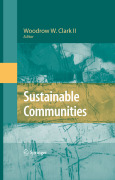
Sustainable communities: toward energy independence and carbon neutral communities
Clark II, W.W.
The book provides a vast, but not the total, amount of materials and data. The intent is to give students of sustainable development some well-established resources and tools. By 2008, the concept of ‘Green’ had been so much in marketing and product services that it lost its meaning. The ‘branding’ of green meant a whole new industrial sector suddenly emerged globally. However, the proof that there is both a Green Revolution and actual solutions to global warmingmust be seen in those sustainable communities who have existed, grown or developed using tested tools for sustainability. One of the key tools is the concern for conservation of natural resources, energy efficiency and the use of renewable energy systems (solar, wind, geothermal and bio-mass among others) along with storage devices for power generation. Communities in Europe and Asia have led the way historically. The book presents actual cases of sustainable communities. Provides advanced and graduate students in a variety of disciplines background, cases and technical tools to make sustainable communities a reality With cases from the USA, Europe and Asia who specifically have become sustainable In all cases, the communities are examples of what regions, cities, towns, and communities such as colleges, film studios, business buildings and shopping malls can do to become sustainable INDICE: From the contents Part I. Overview. 1 Background to Sustainable Development. 2: Global Warming and Climate Change: Community Cases Toward Solutions. Issues of Global Warming/Climate Change. Think Globally and Act Locally: communities. Flex Your Power. Work and Commuting / Mass Transit. Appendices: Examples: Change light bulbs; recycling, paper for plastic bags. 3: Government:the Civic-Market driver toward Sustainable College Communities. 4: ‘Dos Lagos’, Corona, CA. 5: The City of Portland, OR. 6: Sustainable Community: The Townof Frederikshavn, Denmark. 7: Dongtan (Shanghai), PR of China. Part II: The Tools for Sustainable Development. Overview. Appendix A: Sustainable Development. Appendix B: Greenhouse Gas Analysis. Appendix C: Demand Side Management. Appendix D: References and Web Site Data Sources. Appendix E: Data from the Private Sector: entrepreneurial opportunities and new ventures.
- ISBN: 978-1-4419-0218-4
- Editorial: Springer
- Encuadernacion: Cartoné
- Páginas: 300
- Fecha Publicación: 01/08/2009
- Nº Volúmenes: 1
- Idioma: Inglés
